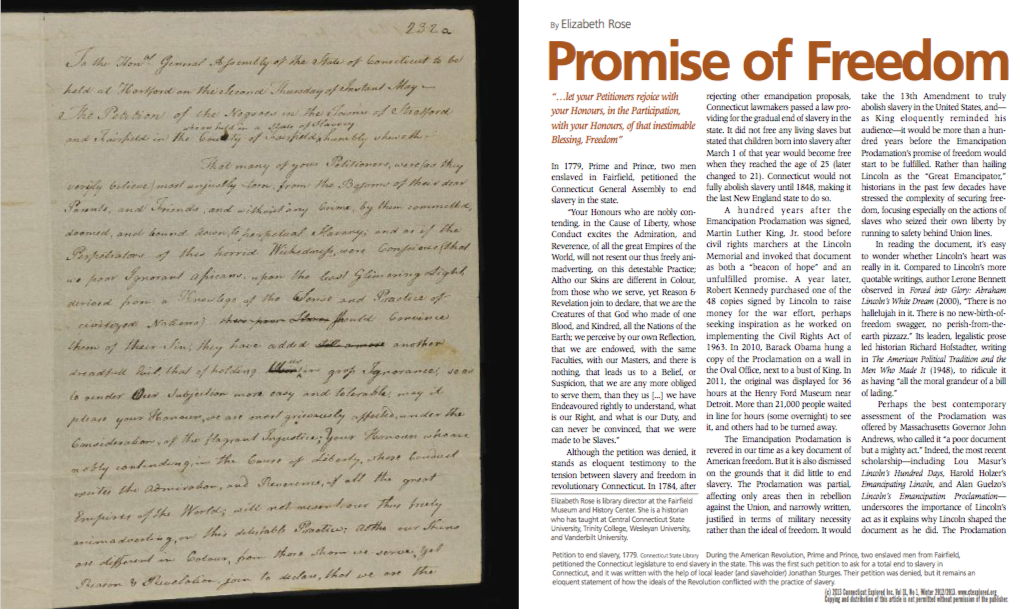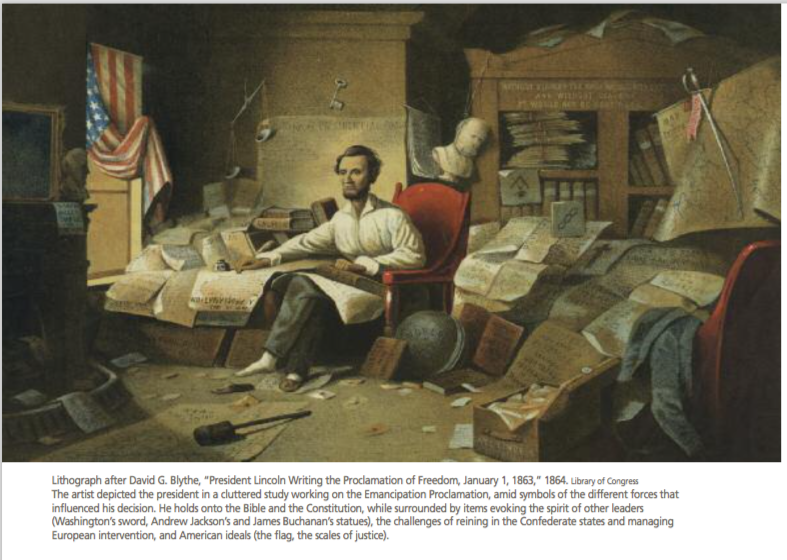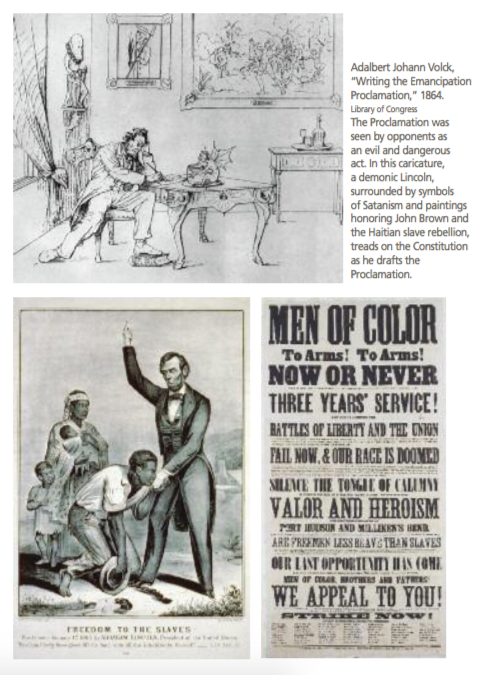to what extent was the emancipation proclamation a document that spurred political action
 Past Elizabeth Rose
Past Elizabeth Rose
(c) Connecticut Explored Inc. Winter 2012/2013
Subscribe/Buy the Issue!
"…allow your Petitioners rejoice with your Honours, in the Participation, with your Honours, of that costive Blessing, Freedom"
In 1779, Prime and Prince, 2 men enslaved in Fairfield, petitioned the Connecticut General Associates to stop slavery in the land.
"Your Honours who are nobly contending, in the Cause of Freedom, whose Deport excites the Admiration, and Reverence, of all the great Empires of the Earth, will not resent our thus freely animadverting, on this detestable Practice;. Altho our Skins are dissimilar in Colour, from those who we serve, yet Reason & Revelation join to declare, that we are the Creatures of that God who made of ane Blood, and Kindred, all the Nations of the Earth; nosotros perceive by our own Reflection, that nosotros are endowed, with the same Faculties, with our Masters, and there is nothing, that leads u.s.a. to a Conventionalities, or Suspicion, that we are any more than obliged to serve them, than they u.s.a. […] we have Endeavoured rightly to understand, what is our Correct, and what is our Duty, and can never exist convinced, that we were fabricated to exist Slaves."
Although the petition was denied, it stands every bit eloquent testimony to the tension between slavery and freedom in revolutionary Connecticut. In 1784, later on rejecting other emancipation proposals, Connecticut lawmakers passed a law providing for the gradual cease of slavery in the state. It did not free any living slaves but stated that children born into slavery after March 1 of that twelvemonth would go free when they reached the age of 25 (afterwards changed to 21). Connecticut would not fully abolish slavery until 1848, making information technology the last New England state to do so.
A hundred years later on the Emancipation Proclamation was signed, Martin Luther King, Jr. stood before ceremonious rights marchers at the Lincoln Memorial and invoked that document as both a "beacon of hope" and an unfulfilled promise. A yr after, Robert Kennedy purchased one of the 48 copies signed by Lincoln to raise money for the war effort for his domicile, perhaps seeking inspiration as he worked on implementing the Civil Rights Act of 1963. In 2010, Barack Obama hung a copy of the Proclamation on a wall in the Oval Office, next to a bust of King. In 2011, the original was displayed for 36 hours at the Henry Ford Museum about Detroit. More than 21,000 people waited in line for hours (some overnight) to see it, and others had to be turned away.
The Emancipation Announcement is revered in our fourth dimension as a key document of American liberty. But information technology is also dismissed on the grounds that information technology did picayune to end slavery. The Proclamation was partial, affecting only areas and so in rebellion confronting the Spousal relationship, and narrowly written, justified in terms of military necessity rather than the ideal of freedom. Information technology would take the 13th Subpoena to truly abolish slavery in the U.s., and—as Rex eloquently reminded his audience—it would be more than than a 100 years before the Emancipation Declaration's promise of liberty would start to be fulfilled. Rather than hailing Lincoln every bit the "Slap-up Emancipator," historians in the by few decades have stressed the complexity of securing liberty, focusing specially on the actions of slaves who seized their own liberty by running to rubber behind Union lines.

"President Lincoln Writing the Proclamation of Liberty," 1864. Library of Congress
In reading the certificate, it's easy to wonder whether Lincoln'due south centre was really in it. Compared to Lincoln'due south more than quotable writings, writer Lerone Bennett observed in Forced into Glory: Abraham Lincoln's White Dream (2000), "At that place is no hallelujah in information technology. At that place is no new-nativity-of-freedom swagger, no perish-from-the-globe pizzazz." Its leaden, legalistic prose led historian Richard Hofstadter, writing in The American Political Tradition and the Men Who Made It (1948), to ridicule it as having "all the moral grandeur of a nib of lading."
Perhaps the best contemporary assessment of the Announcement was offered by Massachusetts Governor John Andrews, who chosen it "a poor document only a mighty deed." Indeed, the most recent scholarship—including Lou Masur's Lincoln's Hundred Days, Harold Holzer'south Emancipating Lincoln, and Alan Guelzo'south Lincoln's Emancipation Proclamation—underscores the importance of Lincoln'due south deed every bit it explains why Lincoln shaped the document as he did. The Proclamation was the goad for, not the final chapter in, the ending of slavery. Information technology immediately freed tens of thousands of slaves in Union-occupied areas and ensured that as Union forces took command of more territory, more widespread emancipation would follow. By committing the nation to ending slavery, information technology transformed the Civil War into a war for freedom, pushing the United states closer to its ideals of liberty and equality. Past inviting African Americans to enlist in the war machine, it paved the way for their inclusion in the nation and the ceremonious and voting rights that were granted under the 14th and 15th amendments.
When the Fairfield Museum and History Center set out to create an exhibition commemorating the 150th ceremony of the Emancipation Proclamation, we knew we wanted to help visitors connect to this landmark document from which we are distanced by time, language, and political context. We looked for different ways the exhibit could help people view the Declaration through a gimmicky lens, explaining the forces that shaped it and highlighting the ways it resonates today.
Broad parallels are not hard to detect. Close examination of the evolution of the Emancipation Proclamation raises questions that are familiar to anyone who follows national politics today: When is the right fourth dimension to deed? How does a leader shape public opinion or respond to it? How does an outsider group become included in the nation? What are the limits of presidential authority during wartime? What course of action is clearly constitutional? How can ordinary people influence political decisions?
The Fairfield Museum's exhibition Promise of Freedom, on view through Feb 24, 2013, explores these questions. To prove how the Emancipation Proclamation fits into the broad sweep of America's history, the exhibit begins with a focus on the ways in which, from the get-go, America'south promise of freedom, showcased in an early print of the Declaration of Independence, existed alongside the reality of slavery. Throughout his political career, Lincoln often invoked the Declaration, insisting that its promise of "life, liberty, and the pursuit of happiness" apply to all. The Declaration is accompanied by a copy of the U.South. Constitution that was printed in the Connecticut Courant during debates over its ratification in 1787; the paper matter-of-factly carried a runaway-slave advertisement alongside the nation's founding document.
Like every important political issue in our commonwealth, the Emancipation Proclamation was deeply contested in its own time, drawing criticism from those who thought it did too little as well as from those who thought it did likewise much. To show how the Proclamation was regarded by different people in its own time, we have surrounded the copy we are displaying—one of a set that Lincoln signed in 1864 to enhance money to assistance Spousal relationship soldiers—with images created by artists and political cartoonists at the time.

Lower left: Currier & Ives, c. 1865. Library of Congress Lower right: Broadside, 1863. The Library Company of Philadelphia
Nigh surprising to modernistic eyes are the negative depictions conveyed in these images: In ane, Lincoln treads on the Constitution equally he drafts the Proclamation, with a demon belongings his inkwell. In some other, he removes a mask to reveal a demonic face. The positive depictions prove him equally the "Groovy Emancipator" hitting the bondage off a kneeling slave or celebrate the moment of emancipation by contrasting the horrors of slavery with the benefits of freedom, which include schooling, wage-earning, and tranquil family life. Excerpts from newspaper editorials include some praising the Announcement every bit "a second Announcement of Independence" and "a great moral landmark" and others condemning information technology as "grossly unconstitutional."
Ane of the more jarring arguments against the Proclamation was that it would incite slave rebellions. One of the editorials warns that slaves would rise upwardly and massacre whites "till their easily are smeared and their appetites glutted with claret." Notably, General George B. McClellan opposed the idea of emancipation when Lincoln issued his preliminary proclamation in September 1862, proverb he could not support "servile insurrection." Every bit information technology happened, it was whites who—during the worst rioting in American history—attacked and killed blacks in New York Urban center'southward 1863 Draft Riots. A letter from Fairfield resident Samuel Morehouse, who was teaching in New York Urban center at the time, describes the violence and concludes, "I saw many things during Monday & Tuesday I hope never to see again."
The exhibition also includes a brief caption of what changed in the hundred days from the preliminary announcement, issued on September 22, 1862, to the last one issued on January 1, 1863. Notably, the last announcement dropped any mention of compensation to slave owners or of sending freed slaves to colonies in Africa or elsewhere. Both compensation and colonization had been part of Lincoln's favored approach to emancipation. He had pushed the slaveholding border states to enact their own emancipation statutes featuring these provisions. In his message to Congress the month before the Proclamation, he proclaimed, "I cannot make it ameliorate known than it already is, that I strongly favor colonization." In fact, the solar day before issuing the Announcement, he signed an agreement to settle v,000 blacks on an island off Haiti. But from January ane, 1863 onward, Lincoln would never again publicly advocate a policy of colonization; instead, he addressed the former slaves as potential wage earners and soldiers.
Indeed, the fact that the Declaration invited freed slaves to become soldiers was virtually as meaning as emancipation itself, for serving in the military meant belonging to the nation. Lincoln became an avid proponent of black war machine service; by war'south end, virtually 180,000 African Americans had served, constituting nearly 10 percent of the Wedlock force. Lincoln pointed to black military machine service when he refused to retract emancipation, saying the promise of freedom, "beingness made, must be kept." To illustrate the importance of this evolution, the exhibit includes a rare tintype of an African-American soldier holding his gun, along with 2 striking recruitment posters proclaiming in assuming letters, "Men of Colour! To Arms! To Arms!" and "Freedom to the Slave."
Promise of Liberty includes a rare copy, signed by Lincoln and congressional leaders in 1865, of the 13th Amendment equally an of import companion to the Proclamation. Lincoln, concerned that his Emancipation Proclamation could exist overturned in court, had advocated behind the scenes for passage of the amendment, which was defeated in the House of Representatives in 1864 and finally passed in 1865. Lincoln, of form, he did not live to come across information technology ratified, merely he would have been gratified to know that it freed nearly a million slaves still held in bondage.
The freedom that the Proclamation helped bring about was incomplete, and the struggle for total liberty would continue for more than a hundred years. Promise of Freedom explores this phenomenon by displaying Thomas Nast cartoons critiquing Reconstruction politics, a Ku Klux Klan robe, and 1950s-era signs for segregated h2o fountains. An interactive surface area allows visitors to explore what freedom meant to erstwhile slaves in the 1860s and how aspects of liberty changed over time. Finally, an excerpt from Martin Luther Rex, Jr.'s speech during the 1963 March on Washington, with his call to fulfill the promise of freedom made a hundred years earlier, connects the modern ceremonious rights movement with the Emancipation Annunciation.
Promise of Freedom includes an ancillary exhibition of iconic photographs from the civil rights movement of the 1960s. The work of documentary photographers Bruce Davidson, Bob Adelman, Gordon Parks, Ernest Withers, and others, on loan from the Howard Greenberg Gallery in New York City, includes images of everyday segregation and violence and of efforts to bring virtually change. These images underline the fact that the cease of slavery was only the beginning of a very long quest for equality.
Although scholars, educators, and journalists take worked hard in recent years to uncover and share the history of Connecticut slavery, the pop perception of slavery as a Southern phenomenon remains. Promise of Freedom reminds visitors that slavery is part of Connecticut'due south—and Fairfield's—story every bit well.
Promise of Freedom features items connected to Fairfield history, such as the 1779 petition from Fairfield slaves excerpted above. Fairfield had 1 of the largest slave populations in Connecticut during the 18th century, and scattered throughout the Fairfield Museum's archives are legal documents reflecting that slavery was a fact of life during this time. These include straightforward documents regarding the auction of slaves, including Amos, age 8, Gin, historic period six, and Nell, historic period 12. It besides includes Connecticut's laws regulating slave behavior, forth with documents shedding calorie-free on what it was like to live through Connecticut'southward menses of gradual emancipation. For example, a slave named Jeffrey was built-in a few years too early on to be afflicted by the gradual emancipation law. He was sold twice before finally beingness freed by his owner in 1812, at age 34.
Promise of Liberty explores the ways in which local residents were engaged with the struggles over slavery's fate in the 19th century. Abolitionists in the area sometimes faced fierce resistance, as when a mob blew upward a church building in the Georgetown section of Wilton later on it hosted abolitionist speakers. Perhaps because of their history of slaveholding, Fairfielders were non prominent in the abolitionist motility in the land. Several Fairfield residents did play key roles in the Connecticut Colonization Order, whose goal of sending freed slaves to create colonies in Liberia and elsewhere was less controversial than outright abolition. Among those active in this effort was local gauge Roger G. Sherman (nephew of Roger Sherman, Connecticut'southward well-known signer of the Annunciation of Independence). Sherman's American Colonization Society certificate, signed by Secretary of State and Speaker of the House Henry Dirt, demonstrates the wide entreatment of this movement, which is rarely remembered today. Finally, the exhibition showcases a collection of artifacts showing means in which people in the Fairfield region were touched past the Civil State of war, whatever their views on slavery.
Elizabeth Rose, Ph.D. is library director at the Fairfield Museum and History Center. She is a historian who has taught at Central Connecticut State University, Trinity College, Wesleyan University, and Vanderbilt University.
Explore!
Read more stories near the Emancipation Proclamation in the Winter 2012/2013 upshot.
Read stories about the African American experience in Connecticut and the Civil War in Connecticut on our TOPICS pages.
Hope of Liberty: The Emancipation Proclamation was on view at the Fairfield Museum and History Center, 370 Beach Road, Fairfield through Feb 24, 2013. For more information visit fairfieldhistory.org.
Promise of Freedom was developed with guest curator Louis Masur of Rutgers Academy and assistance from Seth Kaller, Inc. and was made possible through the generous back up of Connecticut Humanities, People's United Bank, the Fairfield Canton Customs Foundation, Newman'southward Own, and Fairfield University.
Source: https://www.ctexplored.org/reflections-on-the-emancipation-proclamation/
0 Response to "to what extent was the emancipation proclamation a document that spurred political action"
Post a Comment